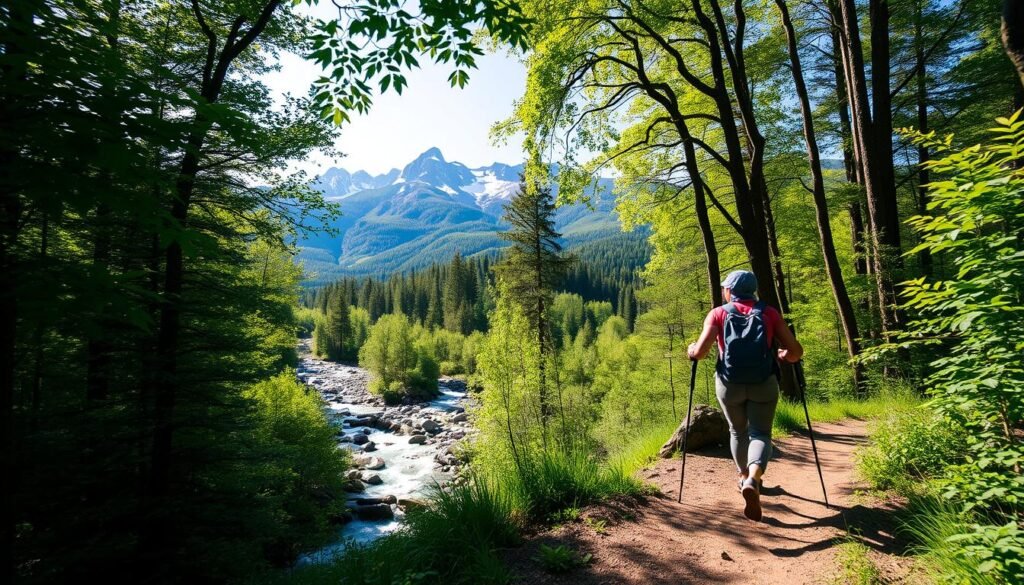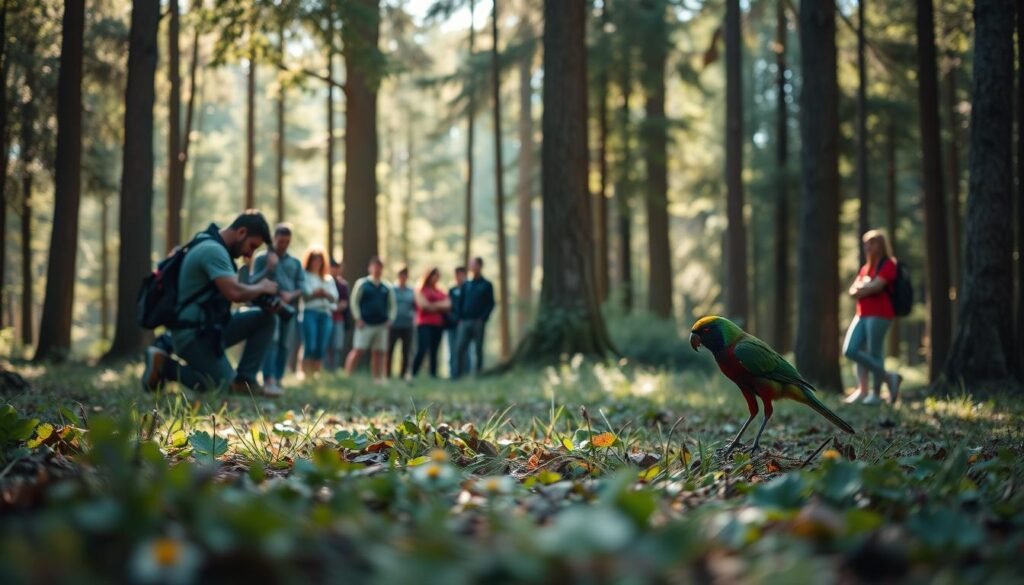Examples Of Ecotourism Activities
The world faces big environmental challenges. Eco-friendly travel is now key to sustainable tourism. It lets travelers see nature’s beauty without harming it.
Ecotourism offers many outdoor activities that help nature and communities. It lets nature lovers help local economies and protect the environment.
More people want to travel in a way that’s good for the planet. It’s important to find the best ecotourism activities. These activities should excite adventure-seekers and help save the planet.
Key Takeaways
- Discover eco-friendly travel options that minimize environmental impact.
- Explore outdoor activities that promote conservation.
- Learn how ecotourism supports local communities.
- Understand the importance of sustainable tourism.
- Find the best ecotourism activities for nature enthusiasts.
What is Ecotourism?
Ecotourism is about visiting nature while keeping it safe. It’s a way of sustainable tourism adventures that helps the environment and local people. It’s becoming more popular because it cares about nature and people.
Defining Ecotourism
Ecotourism means traveling to nature in a way that doesn’t harm it. It’s about nature-based excursions and learning about the environment. This way, people learn to love and protect nature more.
Key Principles of Ecotourism
Ecotourism has important rules. It aims to reduce harm to the environment, respect local cultures, and help conservation. Environmentally conscious tours follow these rules. They help nature and support local people.
- Minimizing waste and pollution
- Respecting local wildlife and habitats
- Supporting conservation initiatives
Benefits of Ecotourism
Ecotourism has many good points. It helps protect nature, helps local communities, and teaches travelers. By joining sustainable tourism adventures, people help save biodiversity and cultural heritage.
It also gives jobs to local people, encouraging them to keep their environment safe. As more people want nature-based excursions, it’s clear we need to travel responsibly.
Popular Ecotourism Destinations in the U.S.
The United States has diverse landscapes perfect for ecotourism. You can find national parks, coastal areas, and wildlife reserves. These spots offer many experiences for those who love nature and adventure.
National Parks
National parks are top picks for ecotourism in the U.S. They provide conservation-focused adventures and wildlife watching tours. Some of the most visited parks are:
- Yellowstone National Park, known for its geothermal features and diverse wildlife.
- Grand Canyon National Park, one of the most iconic natural wonders in the United States.
- Yosemite National Park, famous for its granite cliffs and waterfalls.
Coastal Areas
The U.S. coastline is full of ecotourism opportunities. You can enjoy beach activities and watch marine life. Some notable spots are:
- The Outer Banks in North Carolina, known for their natural beauty and historic lighthouses.
- The Florida Keys, a popular destination for snorkeling and diving.
- The Monterey Bay in California, renowned for its sea life and marine protected areas.
Wildlife Reserves
Wildlife reserves are key for conservation and offer unique ecotourism experiences. Visitors can go on wildlife watching tours and learn about conservation. Examples include:
- The Bosque del Apache National Wildlife Refuge in New Mexico, known for its migratory bird species.
- The Arctic National Wildlife Refuge in Alaska, home to a wide variety of Arctic wildlife.
These places offer adventure and nature appreciation. They also support conservation and local communities.
Unique Ecotourism Activities
Travelers can take part in many ecotourism activities. These activities are eco-friendly and help protect nature. They offer exciting adventures and a chance to connect with nature.
Birdwatching Adventures
Birdwatching is a favorite among nature lovers. It lets them see many bird species in their homes. With the right tools and a guide, it’s a peaceful and fun activity.
Places like national parks and wildlife reserves are great for birdwatching. For example, Florida’s wetlands are perfect for spotting birds like the Roseate Spoonbill and the Bald Eagle.
Guided Nature Walks
Guided nature walks are a great way to explore nature. These walks can be easy or challenging, depending on what you like. You’ll learn about the plants and animals around you.
These walks support responsible travel by helping local guides and conservation. You’ll get to see the area’s beauty up close.
Camping in Natural Reserves
Camping in natural reserves is a special activity. It lets you live in nature for a while. You can stay in campsites within these reserves.
Camping trips can be for everyone, from families to adventure seekers. Many campsites have programs to teach about the environment and conservation.
| Ecotourism Activity | Location | Experience |
|---|---|---|
| Birdwatching | National Parks | Observe diverse bird species |
| Guided Nature Walks | Wildlife Reserves | Explore local flora and fauna |
| Camping | Natural Reserves | Immerse in nature |
Sustainable Travel Practices
In the quest for sustainable tourism adventures, it’s key to grasp the core principles of environmentally conscious tours. These principles are vital for our planet’s preservation.
Travelers hold the power to positively affect the environment and local communities. By embracing sustainable travel, we can lessen our carbon footprint and aid in conservation.
Reducing Carbon Footprint
Choosing eco-friendly transportation is a major step in reducing our carbon footprint. This includes:
- Choosing trains or buses over flights for shorter trips
- Using electric or hybrid vehicles for road trips
- Offsetting carbon emissions from flights by investing in carbon offset projects
Experts stress that reducing carbon emissions is essential to combat climate change’s effects on our ecosystems.
“The tourism industry must adopt sustainable practices to reduce its carbon footprint and ensure a healthier planet for future generations.”
Supporting Local Communities
Supporting local communities is a vital part of sustainable tourism. Engaging with local cultures and economies benefits the communities we visit.
This can be done by:
- Staying in locally owned accommodations
- Eating at local restaurants and cafes
- Participating in community-based tourism initiatives
Choosing Eco-Friendly Accommodations
The type of accommodation we choose is critical in sustainable travel. Eco-friendly hotels and lodges that use renewable energy and reduce waste are best.
When picking accommodations, look for certifications like LEED or EarthCheck. These show a commitment to environmental sustainability.
By making smart choices in our travel habits, we can enjoy sustainable tourism adventures. This way, we contribute to our planet’s preservation.
Wildlife Watching Experiences
Wildlife watching connects us with nature, showing us the beauty and complexity of ecosystems. It lets us see many species in their homes, from big mammals and birds to tiny insects.
Whale Watching Tours
Whale watching tours are thrilling. You can find them in places like California, Alaska, and Hawaii. Seeing whales up close is exciting and teaches you about their lives.
These tours are green and don’t harm the whales or their homes. By picking eco-friendly tours, you help protect whales and their places.
Safari Experiences in National Parks
Safari tours in U.S. national parks are special. Places like Yellowstone and the Great Smoky Mountains are home to many animals. Guides share cool facts about the animals and their homes.
These tours are not just fun. They teach us about protecting wildlife and the parks’ role in it. By visiting, we help keep these places safe for animals.
Responsible Hiking and Trekking
Eco-friendly travel is on the rise, making conservation-focused adventures like hiking and trekking more important than ever. As more people explore nature, it’s key to reduce our environmental impact. This ensures the beauty of nature for future generations.
Hiking and trekking are great ways to connect with nature. But, they can harm the environment if not done right. Responsible hiking and trekking practices are vital for keeping nature beautiful.
Best Practices for Hiking
To hike while protecting the environment, follow these tips:
- Plan your route and stick to trails.
- Take all trash and leftover food with you.
- Don’t disturb wildlife or their homes.
- Conserve water and use it wisely.
Staying on trails prevents erosion and protects habitats. Being prepared and knowledgeable reduces accidents and environmental harm.
Top Ecotrekking Trails in the U.S.
The U.S. has some of the world’s most stunning hiking trails. Here are the top ones:
| Trail Name | Location | Distance |
|---|---|---|
| Appalachian Trail | Eastern United States | 2,190 miles |
| Pacific Crest Trail | Western United States | 2,659 miles |
| John Muir Trail | California, USA | 211 miles |
These trails offer amazing views and unique ecosystems. They’re perfect for conservation-focused adventures. Always follow local rules and respect nature.

By hiking responsibly, we can enjoy nature while helping preserve it. Whether you’re experienced or new to hiking, every step counts in conservation-focused adventures.
Ecotourism and Volunteer Opportunities
Volunteering in ecotourism lets you connect with nature and help conservation. It’s a way to see the beauty of the world and help keep it safe.
Conservation Programs
Many places for ecotourism have programs for conservation. These programs need volunteers for important tasks. Tasks can be anything from helping animals to fixing habitats.
Examples of Conservation Programs:
- Wildlife monitoring and research
- Habitat restoration and reforestation
- Marine conservation efforts
As
“The best way to get a feel for a place is to get involved in its conservation efforts.”
, many people who travel and volunteer agree.
Eco-Volunteering Abroad
Eco-volunteering abroad lets you see new cultures and help the planet. You can work on projects like saving wildlife in Africa or helping the sea in the Pacific. There are many chances to make a difference.
Volunteers can pick from projects like:
- Conservation projects in national parks
- Community-led conservation initiatives
- Research projects focused on biodiversity
By volunteering abroad, you help conservation and learn a lot. You get to see different places and cultures.
Kayaking and Canoeing in Natural Habitats
Kayaks and canoes move quietly through beautiful landscapes. This lets travelers step away from their busy lives and connect with nature. Kayaking and canoeing are calm ways to explore nature-based excursions and environmentally conscious tours.
Best Locations for Kayaking
The United States has many great places for kayaking. You can paddle through the glowing waters of Tomales Bay in California. Or, you can explore the calm rivers of the Okefenokee Swamp in Georgia. Each spot offers a special kayaking adventure.
- The Everglades National Park in Florida, known for its vast mangrove forests and diverse wildlife.
- Puget Sound in Washington, with kayaking routes through islands and chances to see marine life.
Environmental Impact of Water Activities
Kayaking and canoeing are good for the environment because they don’t harm it much. But, we must use green practices to keep nature safe. This means staying away from sensitive spots, not disturbing animals, and using green gear.
Minimizing Environmental Footprint:
- Look for local, eco-friendly tour operators who care about the environment.
- Pay attention to your surroundings and don’t litter or touch sea creatures.
By being green and caring for nature, kayakers and canoeists can have fun while helping protect these places for others in the future.
Wildlife Photography Workshops
Dive into the world of wildlife photography with expert-led workshops. These sessions are a great way to boost your skills and see stunning natural spots.
Learning from Professionals
Wildlife photography workshops let you learn from top photographers. They share their knowledge on techniques, gear, and how to capture amazing shots.
“The best thing about photographing wildlife is the opportunity to connect with nature on a deeper level. It’s not just about taking a picture; it’s about telling a story.” – Annie Leibovitz
At these workshops, you’ll get hands-on experience. You’ll learn about wildlife behavior and photography tech. You’ll also discover how to get close to animals without scaring them away.
Best Locations for Wildlife Photography
The U.S. has many different landscapes, perfect for wildlife photos. From the Pacific Northwest’s forests to the Southwest’s deserts, there’s a lot to see.
| Location | Wildlife | Best Time to Visit |
|---|---|---|
| Yellowstone National Park | Grizzly bears, wolves, elk | Spring and early summer |
| Grand Teton National Park | Elk, moose, bison | Autumn for rutting season |
| Acadia National Park | Deer, seabirds, seals | Early morning for wildlife activity |
Many wildlife photography workshops focus on eco-friendly travel experiences. They work with local conservation groups and promote green tourism.

Wildlife photography workshops are great for both new and experienced photographers. They offer adventure, learning, and a chance to connect with nature. By joining, you’ll improve your skills and help protect wildlife through your photos.
Cultural Immersion Activities
Travelers can dive deep into the rich cultures of places they visit through cultural immersion. This is key to responsible travel activities. It lets tourists connect with local communities and understand the heritage of their destinations better.
Engaging with Indigenous Communities
Meeting indigenous communities offers a real look at a region’s culture. Travelers can join tours led by locals. They learn about traditions, history, and daily life.
This not only makes the trip more meaningful but also helps the local economy. It shows the spirit of sustainable tourism adventures.
“When we engage with local communities, we open ourselves up to new perspectives and ways of life, enriching our travel experience and fostering global understanding.”
Participating in Local Traditions
Getting involved in local traditions is a big part of cultural immersion. Travelers can go to festivals, learn crafts, or join community ceremonies. These activities give a peek into the cultural heart of a place.
- Attend local festivals and events
- Learn traditional crafts and skills
- Participate in community ceremonies and rituals
By taking part in these experiences, travelers help keep cultural heritage alive. They also support local communities, which is at the heart of responsible travel.
Educational Ecotourism Programs
As people become more aware of the environment, educational ecotourism is growing. These programs mix adventure with learning about nature. They’re great for those who love the outdoors and want to learn more.
These programs aim to teach about protecting the environment. They offer conservation-focused adventures that are both fun and educational. They reach out to many people, from school kids to adults.
Eco-Friendly Workshops
Eco-friendly workshops are a big part of these programs. They teach about local ecosystems and how to protect them. Some activities include:
- Wildlife conservation seminars
- Sustainable gardening practices
- Eco-art workshops using natural materials
These workshops teach and let you get your hands dirty. For example, you might help with a habitat restoration project. This teaches you why it’s important to keep local wildlife safe.
School Group Programs
School programs are a key part of educational ecotourism. They’re made for students, with environmentally conscious tours that are fun and educational.
Some activities for school groups are:
- Guided nature walks with expert naturalists
- Environmental science lessons in the field
- Conservation project participation
These programs help kids love nature and care for it. By joining, students learn a lot about the environment and why it’s important to protect it.
Tips for Planning Your Ecotourism Trip
Planning an ecotourism trip needs careful thought. You want it to be memorable and good for the planet. There are many activities, like birdwatching and wildlife photography, to choose from. It’s key to research your destination well.
Researching Your Destination
Understanding your destination is vital in ecotourism. It lets you know about the local environment and climate. You’ll also learn how your visit might affect it. Look for tour operators that offer eco-friendly activities, like nature walks or kayaking.
Packing Essentials
Choosing the right gear is important for a great ecotourism trip. Pack comfortable shoes, eco-friendly sunscreen, and reusable water bottles. This way, you can enjoy your trip while being kind to the environment.

















[…] June 19, 2025Explore the Best Ecotourism Activities for Nature LoversFrom wildlife safaris to susta… […]